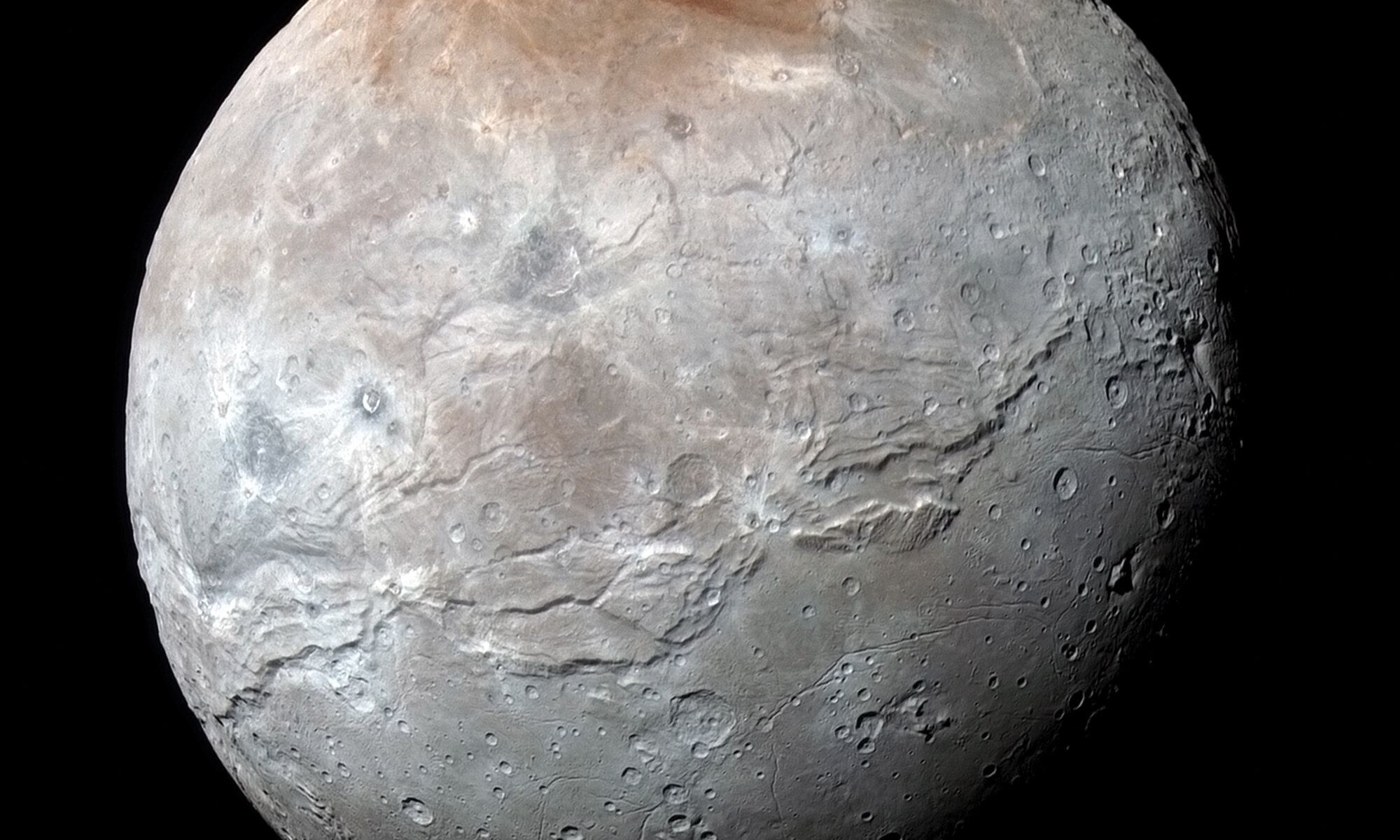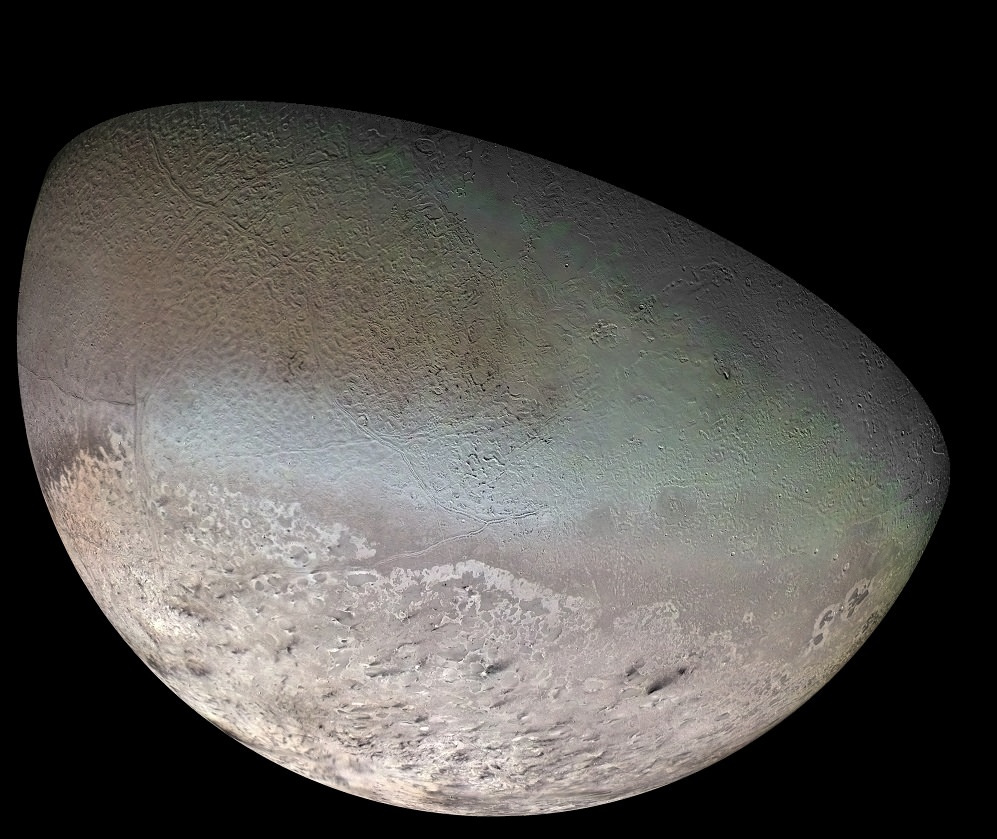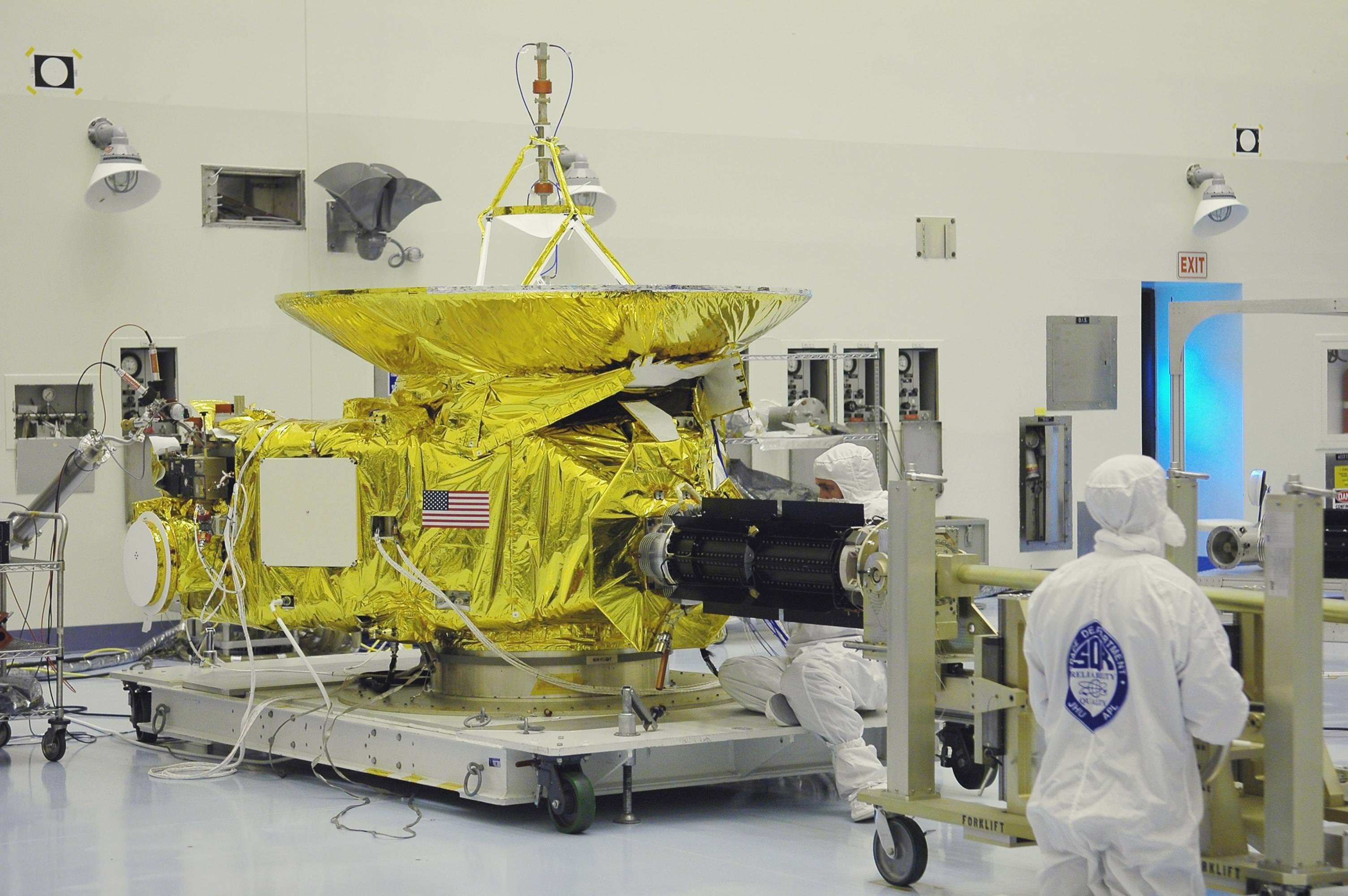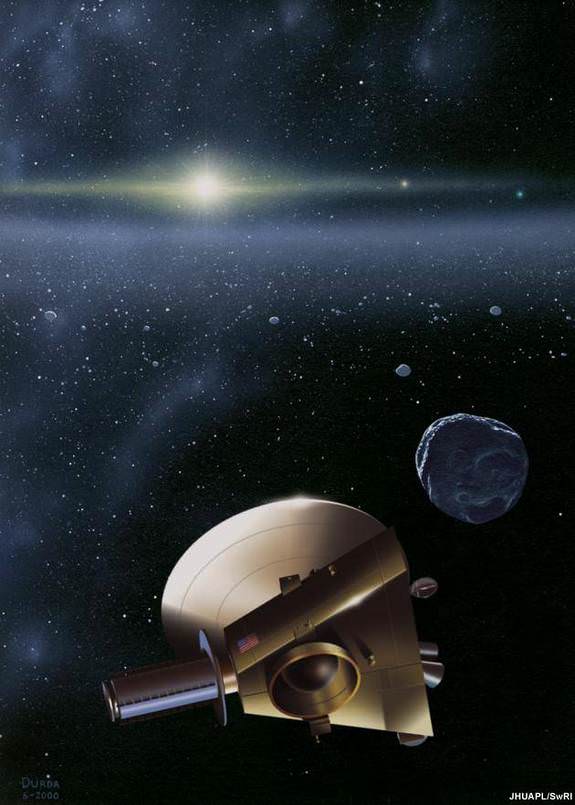Pluto’s largest moon, Charon, started off as a beautiful, smooth red grape until someone came along, mostly peeled it, tried to smoosh it, then just gave up and walked away, leaving the poor moon to look like the absolute travesty that it is. Okay, so maybe that’s not exactly what happened, but Charon just looks like a mess and scientists want to know why. Never mind its smooshed equator, but what’s the deal with its red cap? Where did it come from and why is it red?
Continue reading “Charon’s Red Cap at its North Pole? We Might Have an Answer”NASA Wants to Send a Low-Cost Mission to Explore Neptune’s Moon Triton
In the coming years, NASA has some bold plans to build on the success of the New Horizons mission. Not only did this spacecraft make history by conducting the first-ever flyby of Pluto in 2015, it has since followed up on that by making the first encounter in history with a Kuiper Belt Object (KBO) – 2014 MU69 (aka. Ultima Thule).
Given the wealth of data and stunning images that resulted from these events (which NASA scientists are still processing), other similarly-ambitious missions to explore the outer Solar System are being considered. For example, there is the proposal for the Trident spacecraft, a Discovery-class mission that would reveal things about Neptune’s largest moon, Triton.
Continue reading “NASA Wants to Send a Low-Cost Mission to Explore Neptune’s Moon Triton”Take an Astounding Aerial Flyover Tour Soaring Above Pluto’s Wondrous Heart, Icy Flow Plains and Majestic Mountains
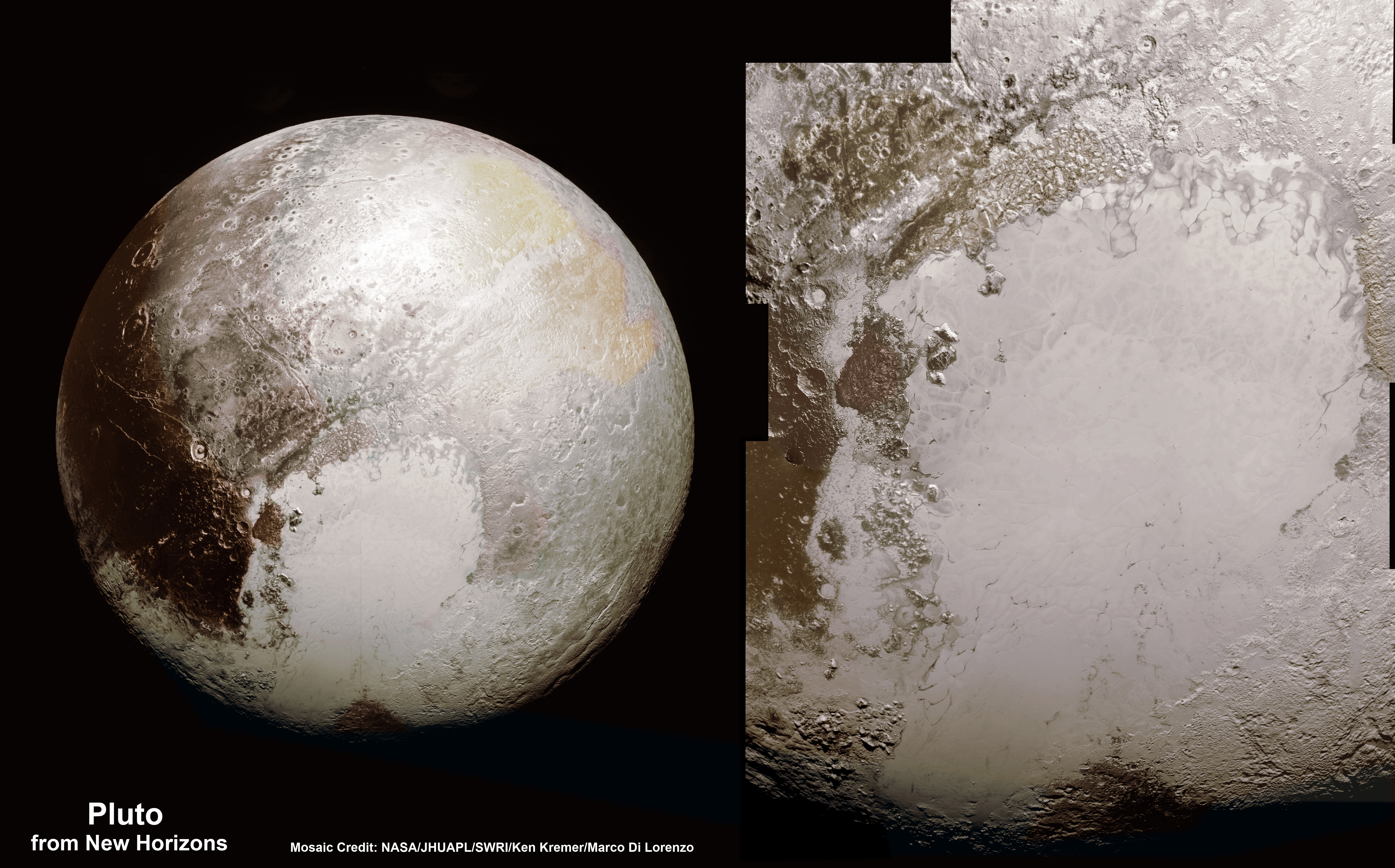
Video caption: This animation of LORRI (Long Range Reconnaissance Imager) images begins with a low-altitude look at the informally named Norgay Montes, flies northward over the boundary between informally named Sputnik Planum and Cthulhu Regio, turns, and drifts slowly east above Pluto’s heart shaped Tombaugh Regio feature. It then rises about 10 times higher in altitude as NASA’s New Horizons flew closest to Pluto on July 14, 2015. Credit: NASA/JHUAPL/SwRI/Stuart Robbins. See additional high resolution global Pluto and Tombaugh Regio mosaics below
Imagine yourself as a once in a lifetime Plutonian tourist sailing along in a spartan spaceship and looking out the windows to breathtaking alien landscapes with cameras snapping away.
Now for the first time in human history, you can embark on a heretofore unimaginable flyover tour over Pluto – the most distant planetary system yet explored by an emissary from Earth, thanks to the team propelling NASA’s New Horizons spacecraft to the far flung reaches of our Solar System.
Just click on the video above and take the astounding aerial flyover tour above Pluto’s huge heart and the icy worlds wondrous array of tectonically active flow plains and majestic mountain ranges towering kilometers skyward to its thin hazy atmosphere.
The animation is a gift to humanity as seen from the perspective of the New Horizons probe as it flew past Pluto on July 14, 2015 at a distance of 50,000 miles (80,000 kilometers).
The new flyover video beautifully melds “art and science” – and is the brainchild of Stuart Robbins, a New Horizons research scientist at the Southwest Research Institute in Boulder, Colorado.
“I have used the latest images to produce an animation that shows what it might be like to take an aerial tour through Pluto’s thin atmosphere and soar above the surface that New Horizons explored,” Robbins explained in a blog posting.
The flyover animation is based on a stitched together mosaic of New Horizons images that were then rendered onto a sphere of Pluto. The animation and spherical mosaic were created by New Horizons team members using the initial batch of images taken by the LORRI (Long Range Reconnaissance Imager) camera and downloaded from the spacecraft as of Sept. 11, 2015.
“The mosaic …. provides an incredibly accurate portrayal of Pluto’s surface. It showcases …. the huge variety of terrain types that we see on Pluto.”
The flyover begins low over the heart shaped region of Pluto informally named Tombaugh Regio by the New Horizons team. The LORRI images at the starting point over the Norgay Montes mountain range have a resolution up to 400 meters per pixel at a altitude of only about 120 miles (200 kilometers). The resolution then changes to about 800 meters per pixel.
The animation concludes with images of approximately 2.1 kilometers per pixel as the apparent altitude increases tenfold to about 1,500 miles (2,500 kilometers) as viewers perspective changes from an up close view to one revealing Pluto’s disk rapidly growing to show about 80% of the hemisphere New Horizons flew closest to on July 14, 2015.
Here is Robbins explanation of the Plutonian terrain visible during your tourists eye view:
“Our tour starts low over the informally named Norgay Montes at a height of about 120 miles (200 kilometers). These jagged mountains rise almost 2 miles (3 kilometers) from the surrounding surface.”
“We head north over Sputnik Planum (bright area to the left) and Cthulhu Regio (dark area to the right). While Sputnik Planum is smooth at this pixel scale, it’s in marked contrast to Cthulhu Regio which has many large impact craters that indicate the Regio is much older. The differences in brightness are some of the largest natural brightness variations of any object in the solar system.”
“Our view steadily rises to a height of about 150 miles (240 kilometers) and turns to look east. From this point, we drift slowly to the east, with Pluto’s north pole to the left, Tombaugh Regio filling much of the middle of the view, and older, more cratered areas standing out in marked contrast to the younger glaciers of the “heart’s” left lobe, Sputnik Planum.”
“As we continue to fly, our flight path rises to more than 1,500 miles (2,500 kilometers) with the final view of most of the disk that New Horizons saw on July 14.”
Robbins role on the New Horizons science team is using the images “to map craters across the surfaces of Pluto and its largest moon, Charon, to understand the population of impactors from the Kuiper Belt striking Pluto and Charon.”
To see and study the whole disk of Pluto and the highest resolution view of the “heart” check out our global Pluto and Tombaugh Regio mosaics generated from raw images captured by New Horizons’ Long Range Reconnaissance Imager (LORRI) and stitched together by the image processing team of Marco Di Lorenzo and Ken Kremer.
New Horizon’s unveiled Pluto as a surprisingly vibrant and geologically active “icy world of wonders” as it barreled past the Pluto-Charon double planet system on July 14 at over 31,000 mph (49,600 kph) and collected unprecedented high resolution imagery and spectral measurements of the utterly alien worlds.
What are Pluto’s newly discovered plains and mountains composed of?
“The plains are made of nitrogen. But nitrogen is too soft a material to build mountains out of, even in Pluto’s weak gravity,” says New Horizons Principal Investigator Alan Stern of the Southwest Research Institute, Boulder, Colorado.
“So the mountains must be made of something else stronger. Rock and water ice are the two most likely possibilities. But they are most likely water ice.”
Here’s our colorized and annotated version of the recently released backlit view of Pluto taken 15 minutes after closest approach as New Horizons spacecraft looked back toward the sun and captured a near-sunset view of the rugged, icy mountains and flat ice plains extending to Pluto’s horizon.
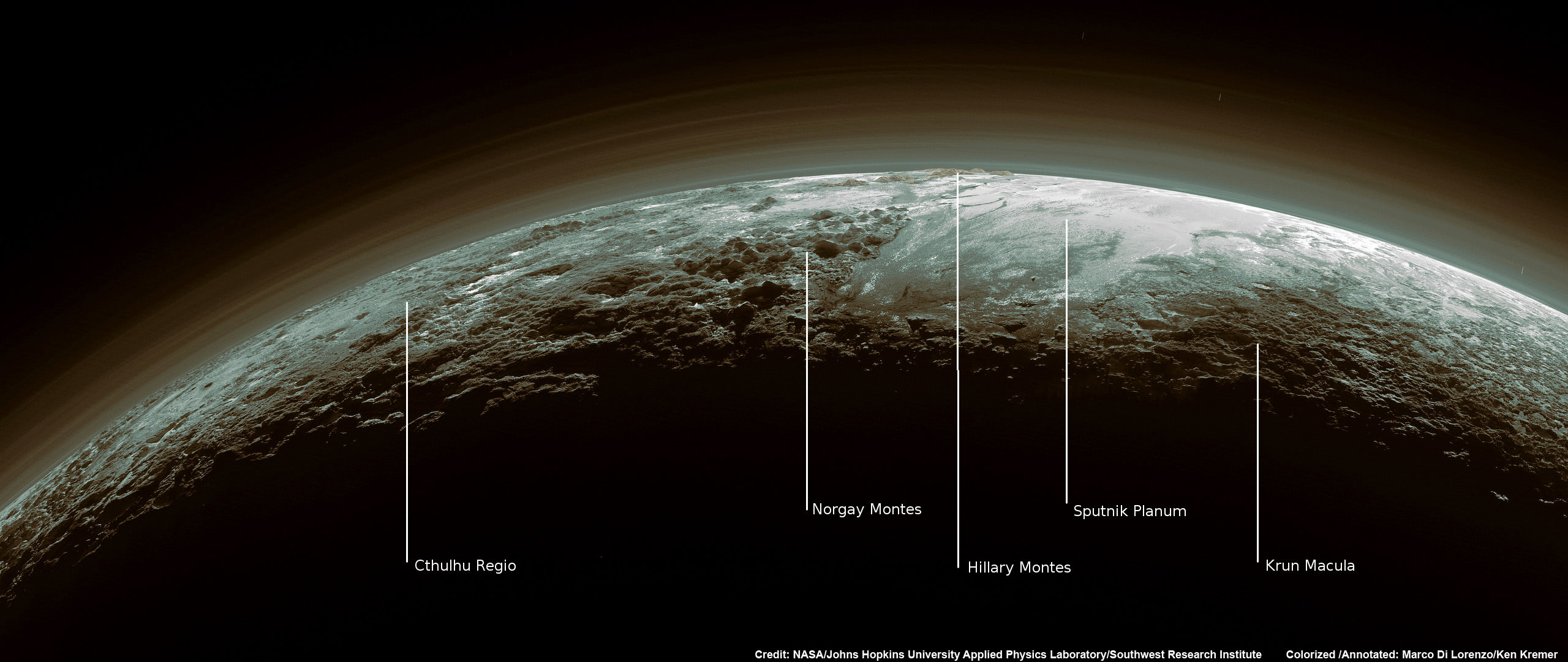
Since the flyby, the team has been busy analyzing the science data returned thus far and “making some discoveries” says Stern.
“Pluto is showing us a diversity of landforms and complexity of processes that rival anything we’ve seen in the solar system.”
“If an artist had painted this Pluto before our flyby, I probably would have called it over the top — but that’s what is actually there.”
New Horizons gathered about 50 gigabits of data as it hurtled past Pluto, its largest moon Charon and four smaller moons.
New Horizons also discovered that Pluto is the biggest object in the outer solar system and thus the ‘King of the Kuiper Belt’.
The Kuiper Belt comprises the third and outermost region of worlds in our solar system.
Only about 5 to 6 percent has been downlinked to Earth so far. Stern says it will take about a year for all the data to get back.
So expect a year of endless treats and surprises from the ‘King of the Kuiper Belt’!
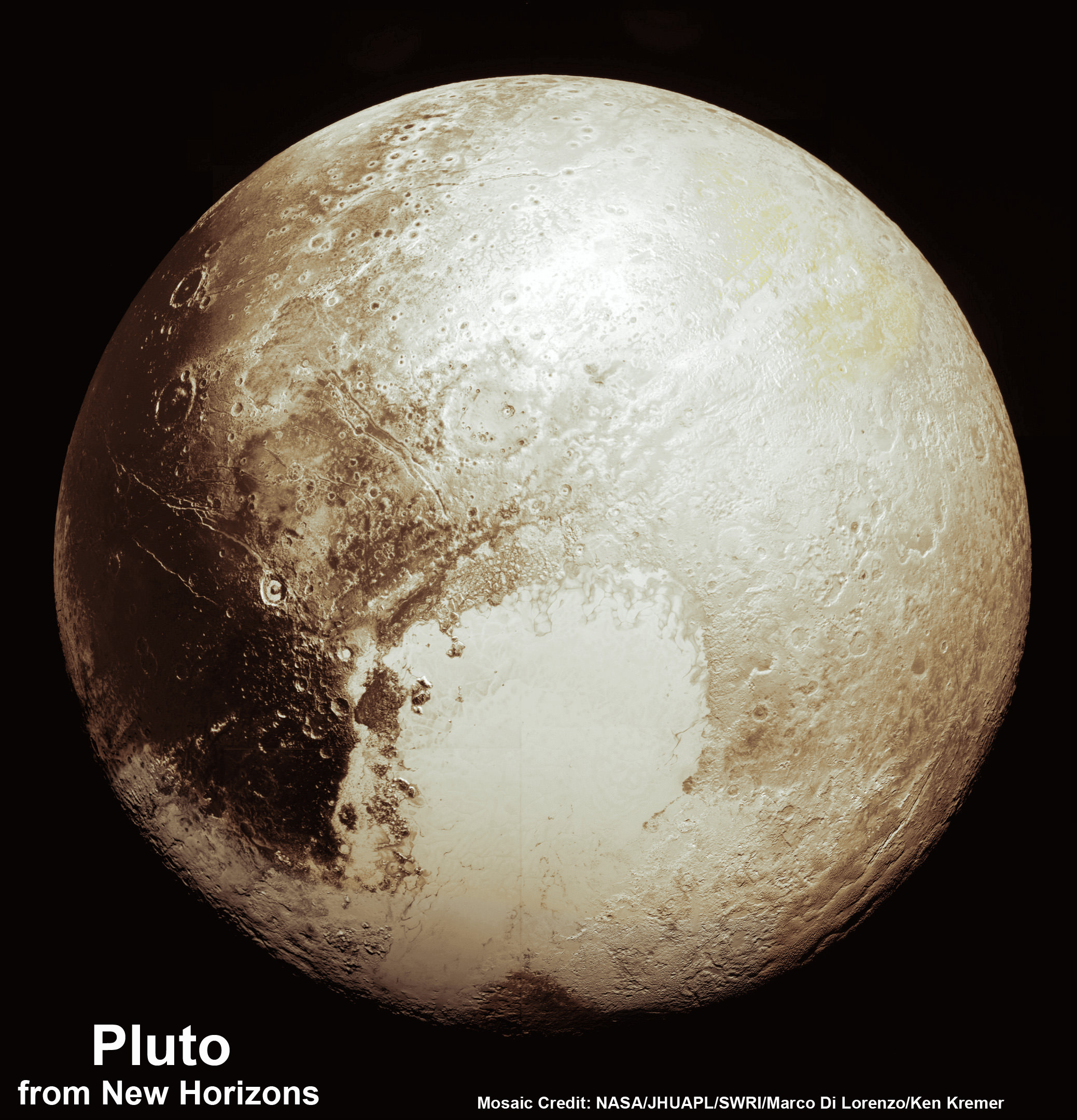
Watch for Ken’s continuing coverage of the Pluto flyby. He was onsite reporting live on the flyby and media briefings for Universe Today from the Johns Hopkins University Applied Physics Laboratory (APL), in Laurel, Md.
Stay tuned here for Ken’s continuing Earth and planetary science and human spaceflight news.
Faces of the Solar System

“Look, it has a tiny face on it!”
This sentiment was echoed ‘round the web recently, as an image of Pluto’s tiny moon Nix was released by the NASA New Horizons team. Sure, we’ve all been there. Lay back in a field on a lazy July summer’s day, and soon, you’ll see faces of all sorts in the puffy stratocumulus clouds holding the promise of afternoon showers.
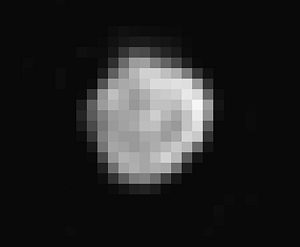
This predilection is so hard-wired into our brains, that often our facial recognition software sees faces where there are none. Certainly, seeing faces is a worthy survival strategy; not only is this aspect of cognition handy in recognizing the friendlies of our own tribe, but it’s also useful in the reading of facial expressions by giving us cues of the myriad ‘tells’ in the social poker game of life.
And yes, there’s a term for the illusion of seeing faces in the visual static: pareidolia. We deal lots with pareidolia in astronomy and skeptical circles. As NASA images of brave new worlds are released, an army of basement bloggers are pouring over them, seeing miniature bigfoots, flowers, and yes, lots of humanoid figures and faces. Two craters and the gash of a trench for a mouth will do.
Now that new images of Pluto and its entourage of moons are pouring in, neural circuits ‘cross the web are misfiring, seeing faces, half-buried alien skeletons and artifacts strewn across Pluto and Charon. Of course, most of these claims are simply hilarious and easily dismissed… no one, for example, thinks the Earth’s Moon is an artificial construct, though its distorted nearside visage has been gazing upon the drama of humanity for millions of years.
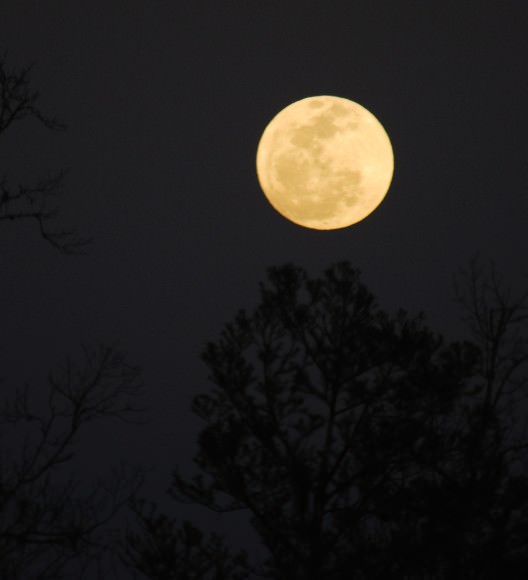
The psychology of seeing faces is such that a whole region of the occipital lobe of the brain known as the fusiform face area is dedicated to facial recognition. We each have a unique set of neurons that fire in patterns to recognize the faces of Donald Trump and Hillary Clinton, and other celebs (thanks, internet).
Damage this area at the base of the brain or mess with its circuitry, and a condition known as prosopagnosia, or face blindness can occur. Author Oliver Sacks and actor Brad Pitt are just a few famous personalities who suffer from this affliction.
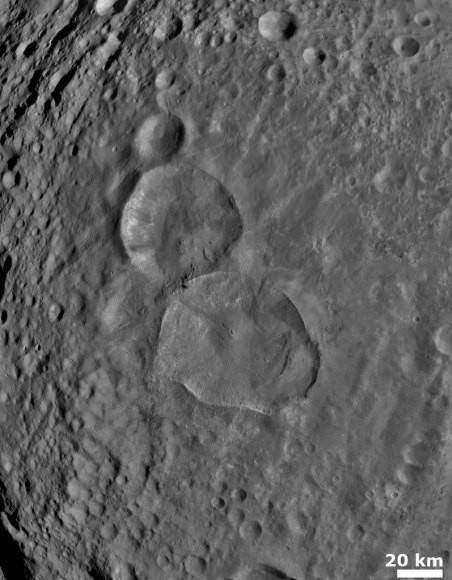
Conversely, ‘super-recognizers’ at the other end of the spectrum have a keen sense for facial identification that verges on a super-power. True story: my wife has just such a gift, and can immediately spot second-string actors and actresses in modern movies from flicks and television shows decades old.
It would be interesting to know if there’s a correlation between face blindness, super-recognition and seeing faces in the shadows and contrast on distant worlds… to our knowledge, no such study has been conducted. Do super-recognizers see faces in the shadowy ridges and craters of the solar system more or less than everyone else?
A well-known example was the infamous ‘Face on Mars.’ Imaged by the Viking 1 orbiter in 1976, this half in shadow image looked like a human face peering back up at us from the surface of the Red Planet from the Cydonia region.
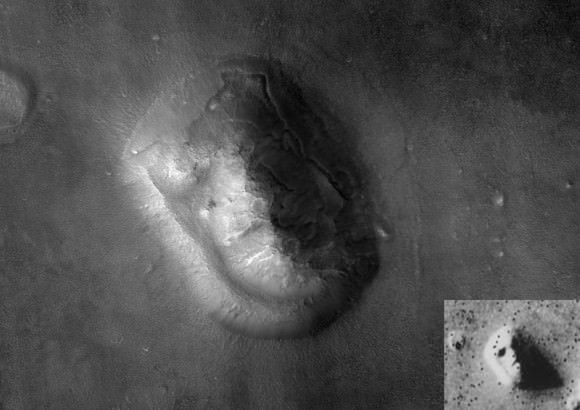
But when is a face not a face?
Now, it’s not an entirely far-fetched idea that an alien entity visiting the solar system would place something (think the monolith on the Moon from Arthur C. Clarke’s 2001: A Space Odyssey) for us to find. The idea is simple: place such an artifact so that it not only sticks out like a sore thumb, but also so it isn’t noticed until we become a space-faring society. Such a serious claim would, however, to paraphrase Carl Sagan, demand serious and rigorous evidence.
But instead of ‘Big NASA’ moving to cover up the ‘face,’ they did indeed re-image the region with both the Mars Reconnaissance Orbiter and Mars Global Surveyor at a much higher resolution. Though the 1.5 kilometer feature is still intriguing from a geological perspective… it’s now highly un-facelike in appearance.
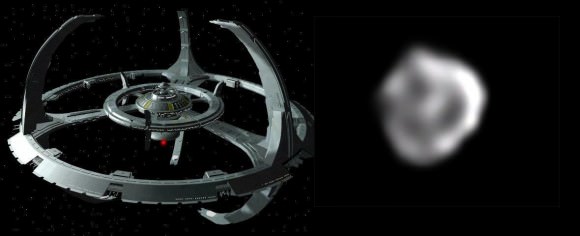
Of course, it won’t stop the deniers from claiming it was all a big cover-up… but if that were the case, why release such images and make them freely available online? We’ve worked in the military before, and can attest that NASA is actually the most transparent of government agencies.
We also know the click bait claims of all sorts of alleged sightings will continue to crop up across the web, with cries of ‘Wake up, Sheeople!’ (usually in all caps) as a brave band of science-writing volunteers continue to smack down astro-pareidolia on a pro bono basis in battle of darkness and light which will probably never end.
What examples of astro-pareidolia have you come across in your exploits?
Mysterious Mountain Revealed in First Close-up of Pluto’s Moon Charon
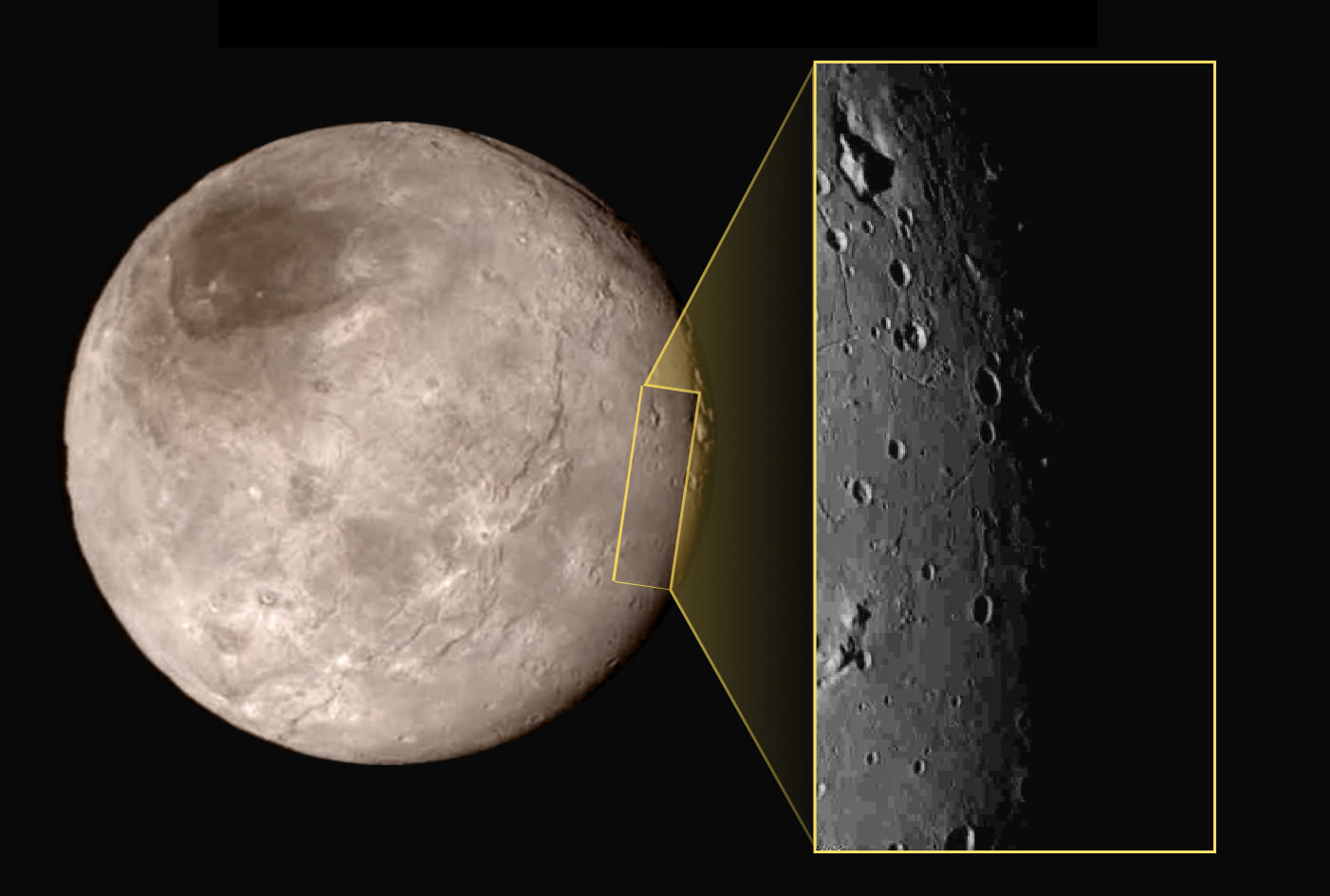
This new image of an area on Pluto’s largest moon Charon has a captivating feature — a depression with a peak in the middle, shown here in the upper left corner of the inset. The image shows an area approximately 240 miles (390 kilometers) from top to bottom, including few visible craters. The image was taken at approximately 6:30 a.m. EDT on July 14, 2015, about 1.5 hours before closest approach to Pluto, from a range of 49,000 miles (79,000 kilometers). Credits: NASA-JHUAPL-SwRI
Story updated[/caption]
APPLIED PHYSICS LABORATORY, LAUREL, MD – A mysterious mountain in the middle of a moat on Pluto’s biggest moon Charon, has captivated and baffled scientists leading NASA’s New Horizons mission which made history when it became the first spacecraft to visit our solar system’s most distant planet barely two days ago on Tuesday morning, July 14, 2015.
NASA released the first close-up image of Charon today (July 16), shown above, and it has the geology team scratching their heads in amazement and wonder. They can’t figure out the nature of a big mountain set inside a moat.
The new image shows a depression with a mountain peak in the middle.
“The most intriguing feature is a large mountain sitting in a moat,” said Jeff Moore with NASA’s Ames Research Center, Moffett Field, California, who leads New Horizons’ Geology, Geophysics and Imaging team. “This is a feature that has geologists stunned and stumped.”
The location of the “mountain in a moat” is shown in the inset of a global view of Charon.
The new high resolution image of Charon was taken at approximately 6:30 a.m. EDT (10:30 UTC), barely an hour and a half before the piano-shaped spacecraft’s closest approach to Pluto on July 14, 2015, from a range of only 49,000 miles (79,000 kilometers).
The image was captured by New Horizons’ high resolution Long Range Reconnaissance Imager (LORRI).
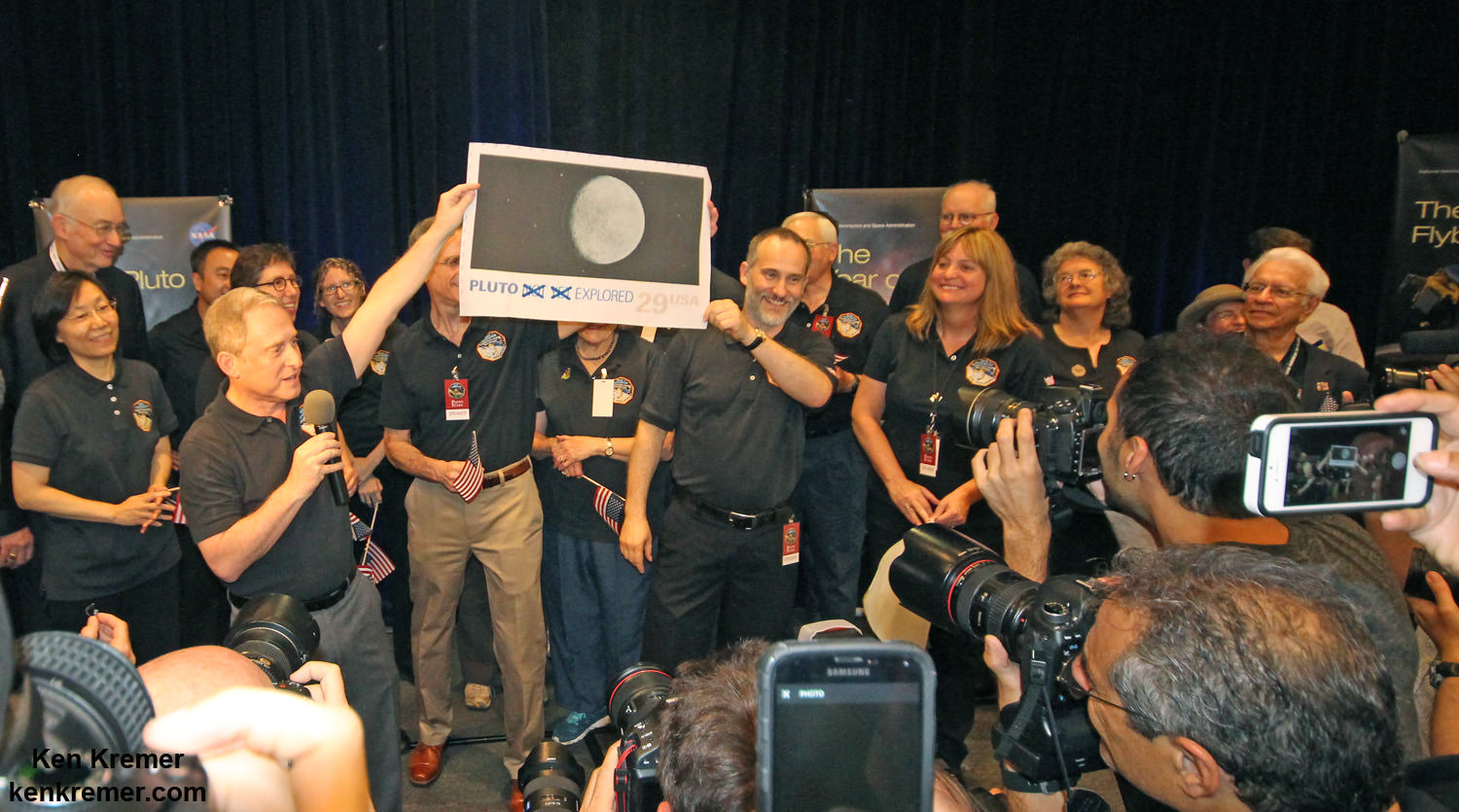
The New Horizons mission team celebrates successful flyby of Pluto in the moments after closest approach at 7:49 a.m. EDT on July 14, 2015. New Horizons Principal Investigator Alan Stern of Southwest Research Institute (SwRI), Boulder, CO., left, Johns Hopkins University Applied Physics Laboratory (APL) Director Ralph Semmel, center, and New Horizons Co-Investigator Will Grundy Lowell Observatory hold an enlarged print of an U.S. stamp with their suggested update after Pluto became the final planet in our solar system to be explored by an American space probe (crossing out the words ‘not yet’) – at the Johns Hopkins University Applied Physics Laboratory (APL) in Laurel, Maryland. Credit: Ken Kremer/kenkremer.com
A much sharper view is yet to come, because the image is heavily compressed.
“Sharper versions are anticipated when the full-fidelity data from New Horizons’ Long Range Reconnaissance Imager (LORRI) are returned to Earth,” say NASA officials.
Altogether it will take 16 months to transmit all the data collected by New Horizons at the Pluto system.
The area in the LORRI image comprises an area approximately 240 miles (390 kilometers) from top to bottom.
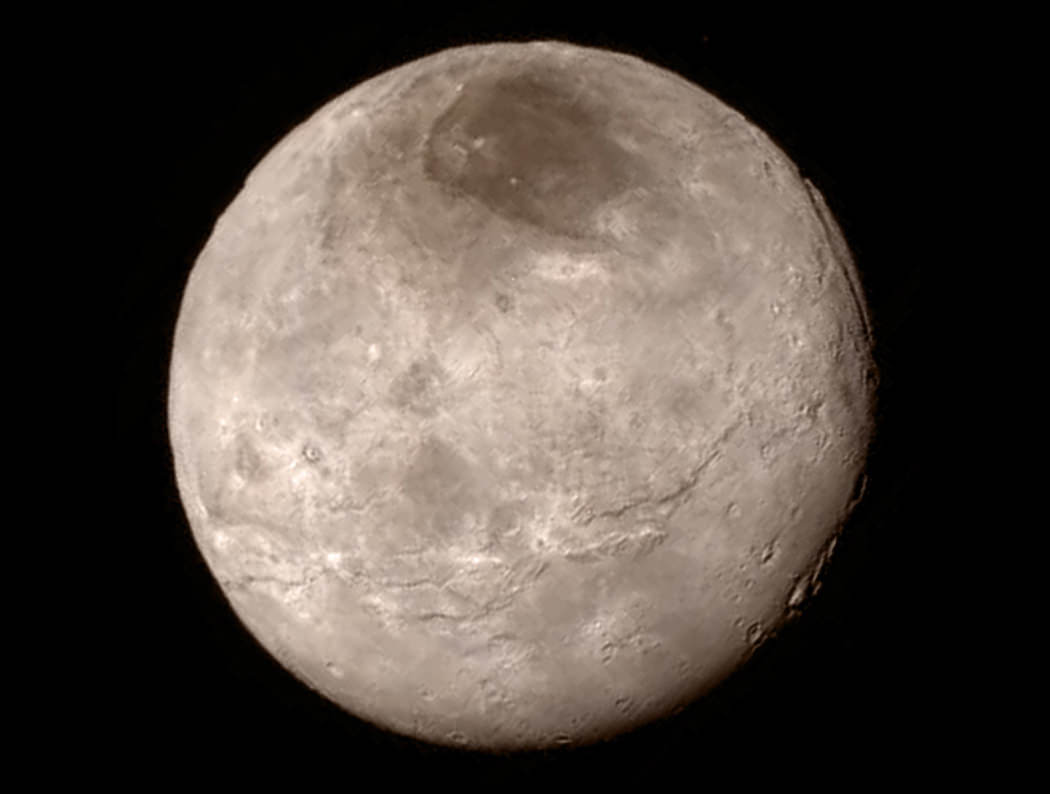
Notably there are few visible craters “indicating a relatively young surface that has been reshaped by geologic activity.”
And a “swath of cliffs and troughs stretching about 600 miles (1,000 kilometers) suggests widespread fracturing of Charon’s crust, likely the result of internal geological processes,” notes the team.
The Texas-sized moon measures about 750 miles (1200 kilometers) across, about half the diameter of Pluto. Pluto spans 1,471 miles (2,368 km) across.
After a nine year voyage through interplanetary space, New Horizons barreled past the Pluto system on Tuesday, July 14 for a history making first ever flyby at over 31,000 mph (49,600 kph), and survived the passage by swooping barely 7,750 miles (12,500 kilometers) above the planet’s amazingly diverse surface at 7:49 a.m. EDT. It passed about 17,900 miles (28,800 kilometers) from Charon during closest approach.
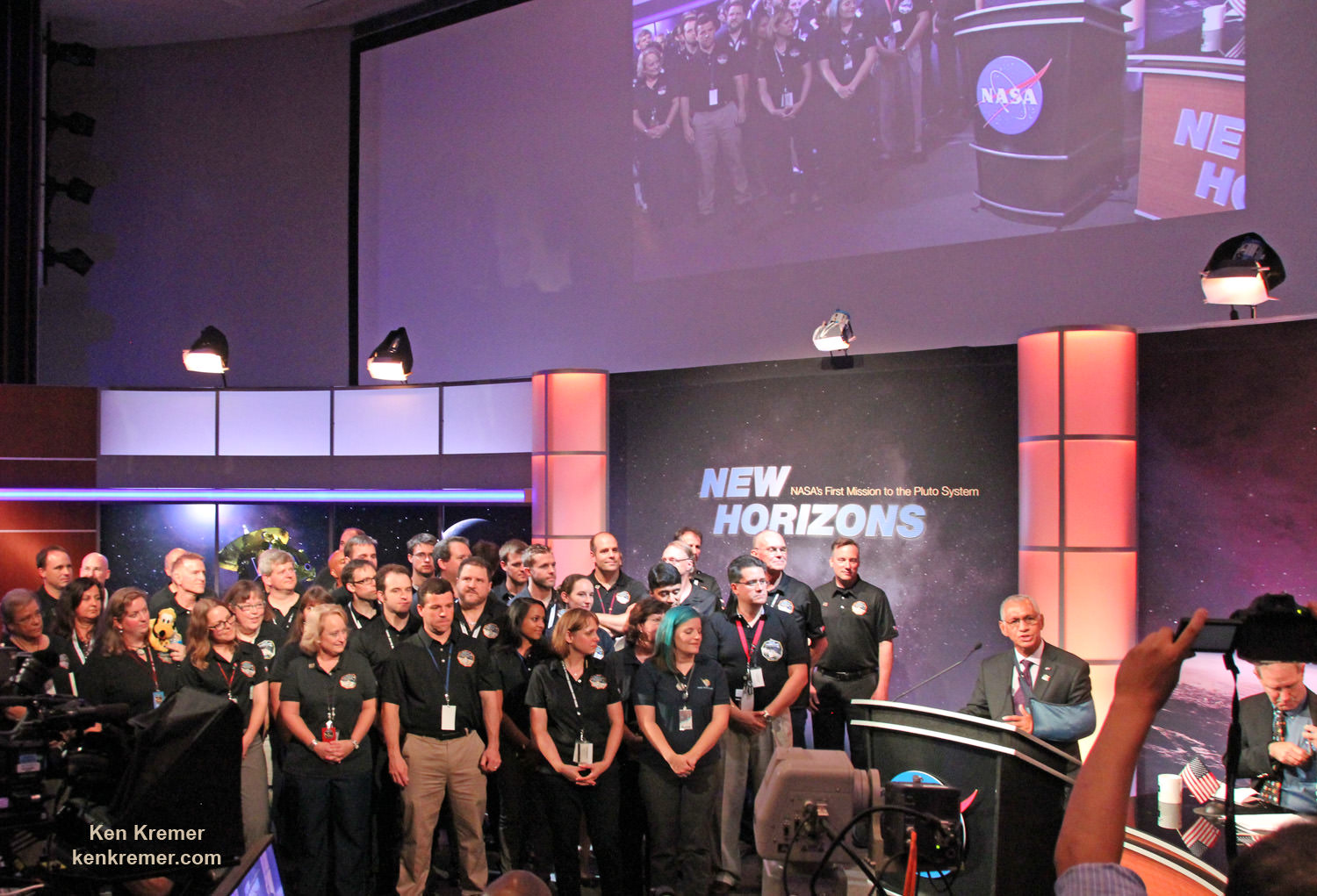
Watch for Ken’s continuing coverage of the Pluto flyby on July 14. He was onsite reporting live on the flyby and media briefing from the Johns Hopkins University Applied Physics Laboratory (APL).
New images will be released on Friday, July 17 – watch for my story.
Stay tuned here for Ken’s continuing Earth and planetary science and human spaceflight news.

Charon Up Close Reveals Colossal Chasms and Craters: 1 Day and 1 Million Miles Out from Pluto Flyby

Chasms, craters, and a dark north polar region are revealed in this image of Pluto’s largest moon Charon taken by New Horizons on July 11, 2015. The annotated version includes a diagram showing Charon’s north pole, equator, and central meridian, with the features highlighted. Credits: NASA/JHUAPL/SWRI
Story/imagery updated[/caption]
In the final days before humankinds first ever flyby of mysterious and tantalizing Pluto for the history making up close visit on Tuesday, July 14, NASA’s New Horizons spacecraft has just delivered the sharpest and most stunning view yet of its binary companion Charon – and unveiled it to be a geologically rich world with colossal chasms, a multitude of craters and a humongous dark splotch in the northern regions. It’s obviously quite different in appearance and varies in composition from its larger planetary host.
Indeed the largest of Charon’s chasms stretches farther than Earth’s Grand Canyon. And it’s taken New Horizons over nine years speeding through space – since launching back in 2006 as the fastest spacecraft departing Earth – to get close enough to see these wonders for the first time.
“The most pronounced chasm, which lies in the southern hemisphere, is longer and miles deeper than Earth’s Grand Canyon,” says William McKinnon, deputy lead scientist with New Horizon’s Geology and Geophysics investigation team, in a NASA statement.
To put that into perspective, consider this; Charon is only about 750 miles (1200 kilometers) across, about half the diameter of Pluto. The Grand Canyon stretches 277 miles (446 km) across the western United States and is up to 18 miles (29 km) wide and attains a depth of over a mile (6093 feet or 1857 meters). Thus Charon’s ‘Grand Canyon’ is truly gargantuan in comparison to its moons size when compared to our Grand Canyon.
At 1471 miles (2368 km) across, Pluto is about half the diameter of the United States. Both Pluto and Charon and largely composed of icy materials, with much less rock compared to the terrestrial planets like Earth.
“This is the first clear evidence of faulting and surface disruption on Charon,” says McKinnon, who is based at the Washington University in St. Louis.
“New Horizons has transformed our view of this distant moon from a nearly featureless ball of ice to a world displaying all kinds of geologic activity.”
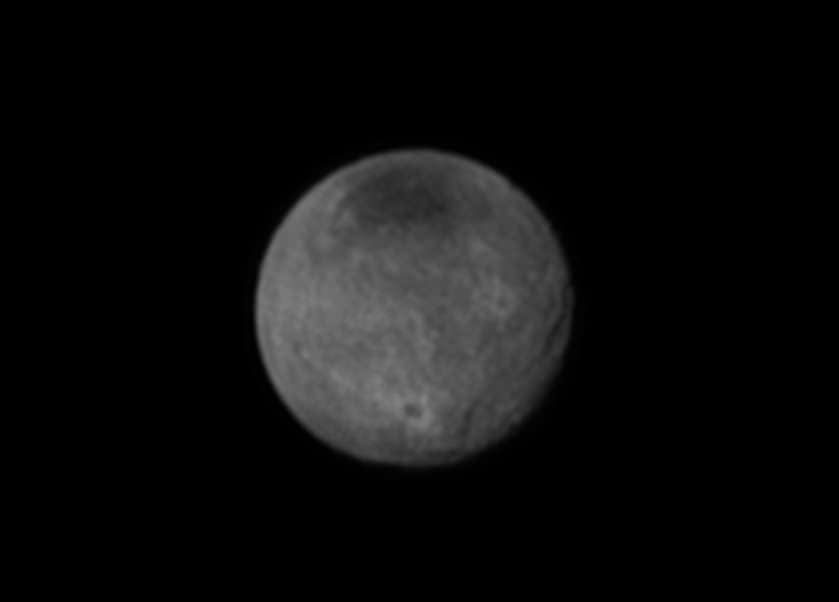
The exquisite new image of Charon’s chasms and canyons was just released by NASA this evening, Sunday, July 12. It was taken yesterday, Saturday, July 11, by New Horizons Long Range Reconnaissance Imager (LORRI) at a distance of 2.5 million miles (4 million kilometers) from Pluto and Charon, and radioed back to Earth today.
The largest crater seen in the July 11 images lies near Charon’s south pole and is about 60 miles (96.5 kilometers) across.
“The brightness of the rays of material blasted out of the crater suggest it formed relatively recently in geologic terms, during a collision with a small body some time in the last billion million years,” says the team.
“The darkness of the crater’s floor is especially intriguing,” says McKinnon.
“One explanation is that the crater has exposed a different type of icy material than the more reflective ices that lie on the surface. Another possibility is that the ice in the crater floor is the same material as its surroundings but has a larger ice grain size, which reflects less sunlight. In this scenario, the impactor that gouged the crater melted the ice in the crater floor, which then refroze into larger grains.”
New Horizons is now merely one day and one million miles (1.6 million km) out from its history making encounter with the Pluto planetary system – some three billion miles (4.8 billion km) from Earth. It passed the million mile milestone at 11:23 p.m. EDT, Sunday night July 12.
And its closing in fast on its quarry at a whopping 31,000 mph (49,600 kph) after a nine year interplanetary voyage.
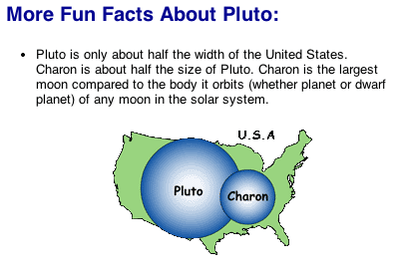
The high resolution LORRI imager is achieving an image resolution of 5 mile per pixel at this moment at a million miles away. And it will gets thousands of times better during the closest approach.
“Features as small as the lakes in New York’s Central Park and wharfs on the Hudson will be resolved,” said New Horizons principal investigator Alan Stern of the Southwest Research Institute, Boulder, Colorado, during a live mission update today, July 12. The image resolution will reach a maximum of about 230 feet (70 meters).
New Horizons suite of seven science instruments will collected 44 gigabits of data during the flyby encounter period lasting from July 7 to July 16, from Pluto, Charon and the four tiny moons – Hydra, Styx, Nix and Kerberos.
New Horizons will swoop to within about 12,500 kilometers (nearly 7,750 miles) of Pluto’s surface and about 17,900 miles (28,800 kilometers) from Charon during closest approach at approximately 7:49 a.m. EDT (11:49 UTC) on July 14.
Pluto and Charon are gravitationally locked with an orbital period of 6.4 days, so they always show the same face to one another. They orbit about 12,160 mi (19,570 kilometers) apart but about a center of gravity, or barycenter, above the surface of Pluto, unlike any of the other major bodies in our solar system.
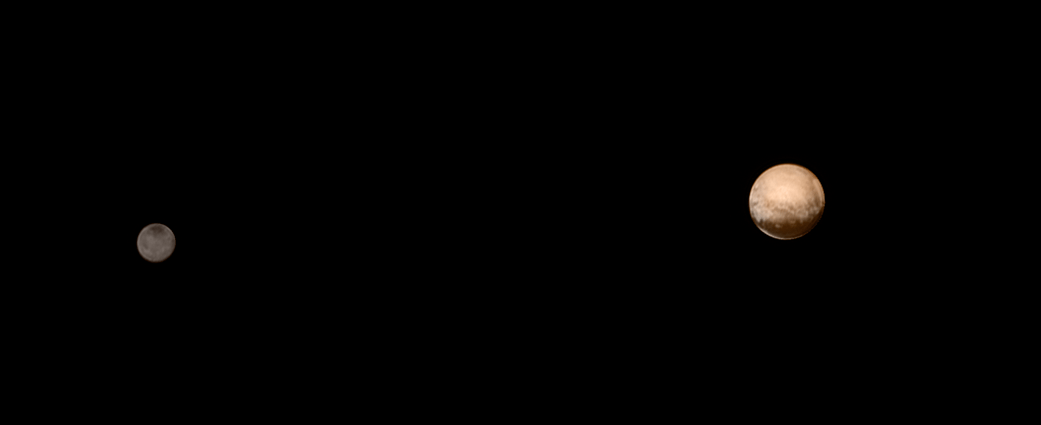
Charon is by far the largest of Pluto’s five moons. The new July 11 image also shows that it sports a “mysterious dark region” stretching some 200 miles across near the north pole.
Pluto is the last of the nine classical planets to be explored up close and completes the initial the initial reconnaissance of the solar system nearly six decades after the dawn of the space age. It represents a whole new class of objects known as the ice dwarfs, located in the Kuiper Belt – a relic of solar system formation replete with countless bodies.
It has been three decades since we last visited planetary bodies at the outer reaches of our solar system when Voyager 2 flew past Uranus and Neptune in 1986 and 1989.
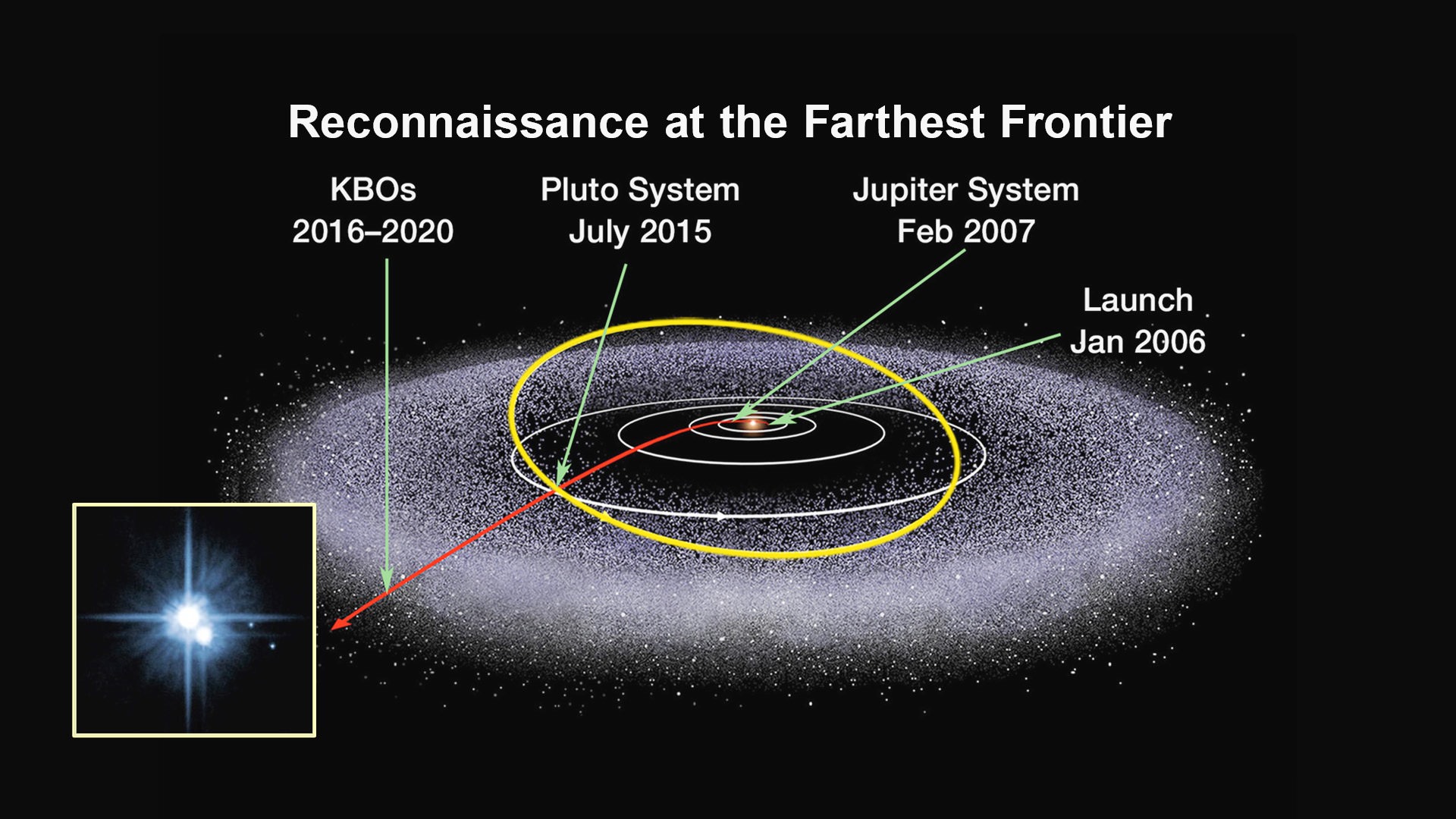
The New Frontiers spacecraft was built by a team led by Stern and included researchers from SwRI and the Johns Hopkins University Applied Physics Laboratory (APL) in Laurel, Maryland. APL also operates the New Horizons spacecraft and manages the mission.
Watch for Ken’s continuing onsite coverage of the Pluto flyby on July 14 from the Johns Hopkins University Applied Physics Laboratory (APL).
Stay tuned here for Ken’s continuing Earth and planetary science and human spaceflight news.
Last, Best Look at Pluto’s Far Side and Four Perplexing Spots: 2 Days Out from Flyby

New Horizons’ last look at Pluto’s Charon-facing hemisphere reveals the highest resolution view of four intriguing darks spots for decades to come. This image, taken early the morning of July 11, 2015, shows newly-resolved linear features above the equatorial region that intersect, suggestive of polygonal shapes. This image was captured when the spacecraft was 2.5 million miles (4 million kilometers) from Pluto. Credit: NASA/JHUAPL/SWRI
Story updated[/caption]
Today (July 11) we got our last, best and clearest look at a quartet of perplexing dark spots on Pluto’s far side from NASA’s New Horizons spacecraft – now just two days and two million miles (4 million km) out from history’s first ever up close flyby of the Pluto system on Tuesday, July 14.
The four puzzling spots (see above) are located on the hemisphere of Pluto which always faces its largest moon, Charon, and have captivated the scientists and public alike. Pluto and Charon are gravitationally locked with an orbital period of 6.4 days.
Over only the past few days, we are finally witnessing an amazing assortment of geological wonders emerge into focus from these never before seen worlds – as promised by the New Horizons team over a decade ago.
Be sure to take a good hard look at the image, because these spots and Pluto’s Charon-facing hemisphere will not be visible to New Horizons cameras and spectrometers during the historic July 14 encounter as the spacecraft whizzes by the binary worlds at speeds of some 30,800 miles per hour (more than 48,600 kilometers per hour) for their first up close reconnaissance.
And it’s likely to be many decades before the next visitor from Earth arrives at the frigid worlds at the far flung reaches of our solar system for a longer look, hopefully from orbit.
“The [July 11] image is the last, best look that anyone will have of Pluto’s far side for decades to come,” said New Horizons principal investigator Alan Stern of the Southwest Research Institute, Boulder, Colorado, in a statement.
The image of the mysterious spots was taken earlier today (July 11) by New Horizons Long Range Reconnaissance Imager (LORRI) at a distance of 2.5 million miles (4 million kilometers) from Pluto, and just released by NASA. The image resolution is 10 miles per pixel. One week ago it was only 40 miles per pixel.
They were first seen only in very recent LORRI images as Pluto’s disk finally was resolved and are located in a Missouri sized area about 300 miles (480 kilometers) across and above the equatorial region.
But until today they were still rather fuzzy – see image below from July 3! What a difference a few million miles (km) makes!
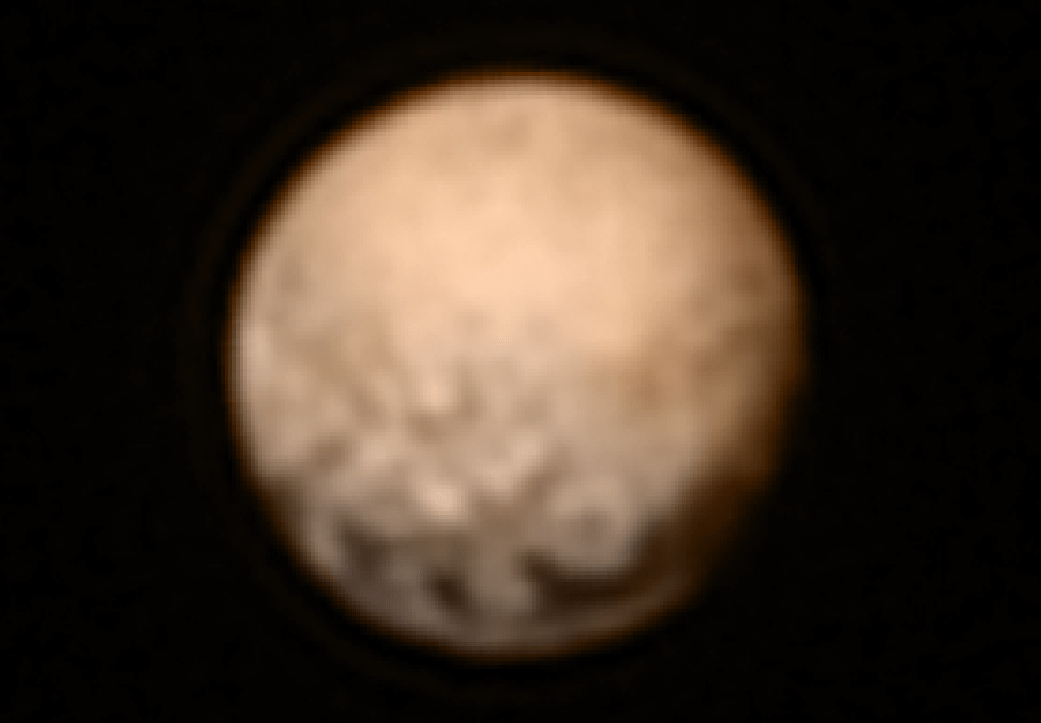
“The Pluto system is totally unknown territory,” said Dr. John Spencer, New Horizons co-investigator at today’s (July 11) daily live briefing from NASA and the New Horizons team.
“Pluto is like nowhere we’ve even been before. It is unlike anything we’ve visited before.”
Now, with the $700 million NASA planetary probe millions of miles closer to the double planet, the picture resolution has increased dramatically and the team can at least speculate.
Researchers say the quartet of “equally spaced” dark splotches are “suggestive of polygonal shapes” and the “boundaries between the dark and bright terrains are irregular and sharply defined.”
“It’s weird that they’re spaced so regularly,” says New Horizons program scientist Curt Niebur at NASA Headquarters in Washington.
However their nature remains “intriguing” and truly “unknown.”
“We can’t tell whether they’re plateaus or plains, or whether they’re brightness variations on a completely smooth surface,” added Jeff Moore of NASA’s Ames Research Center, Mountain View, California.
“It’s amazing what we are seeing now in the images, showing us things we’ve never seen before,” said Spencer.
“Every day we see things we never knew before. We see these crazy black and white patterns. And we have no idea what these mean.”
Answering these questions and more is what the encounter is all about.
Pluto is just chock full of mysteries, with new ones emerging every day as New Horizons at last homes in on its quarry, and the planet grows from a spot to an enlarging disk with never before seen surface features, three billion miles from Earth after an interplanetary journey of some nine and a half years.
“We see circular things and wonder are those craters? Or are they something else,” Spencer elaborated.
“We saw circular features on Neptune’s moon Triton that are not craters. So we should know in a few days . But right now we are just having an awful lot of fun just speculating. It’s just amazing.”
Until a few days ago, we didn’t know that “the other Red Planet” had a big bright heart and a dark ‘whale-shaped’ feature – see my earlier articles; here and here.
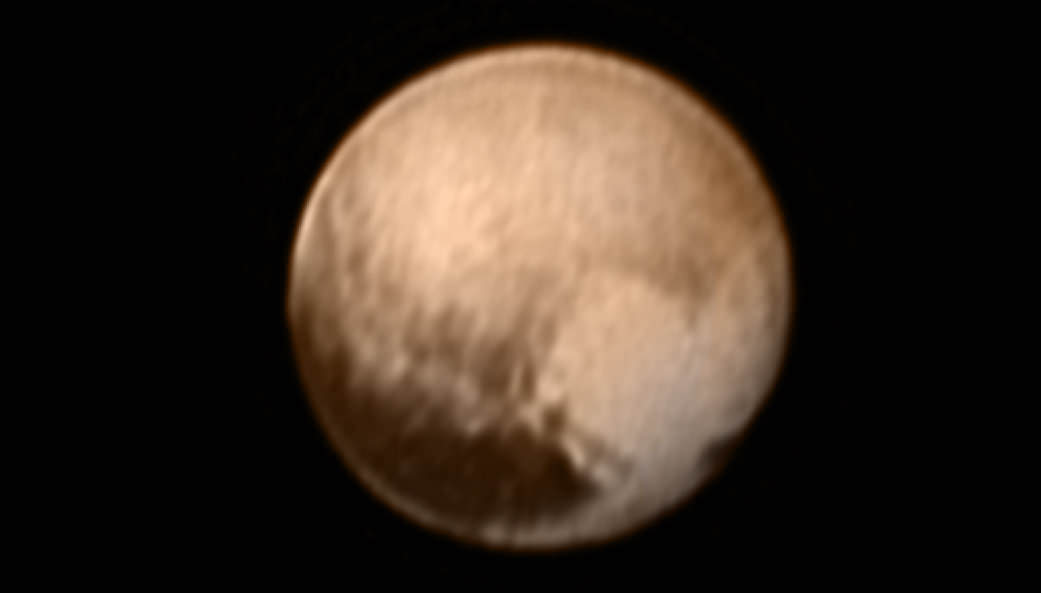
“When we combine images like this of the far side with composition and color data the spacecraft has already acquired but not yet sent to Earth, we expect to be able to read the history of this face of Pluto,” Moore explained.
New Horizons will swoop to within about 12,500 kilometers (nearly 7,750 miles) of Pluto’s surface and about 17,900 miles (28,800 kilometers) from Charon during closest approach at approximately 7:49 a.m. EDT (11:49 UTC) on July 14.
The probe was launched back on Jan. 19, 2006 on a United Launch Alliance Atlas V rocket on a 9 year voyage of over 3.6 billion miles (5.7 billion km).
Pluto is the last of the nine classical planets to be explored up close and completes the initial the initial reconnaissance of the solar system nearly six decades after the dawn of the space age. It represents a whole new class of objects.
“Pluto is a member of a whole new family of objects,” said Jim Green, director of Planetary Science, NASA Headquarters, Washington, in today’s live Pluto update.
“We call that the Kuiper Belt. And it is the outer solar system.”
New Horizons is equipped with a suite of seven science instruments gathering data during the approach and encounter phases with the Pluto system.
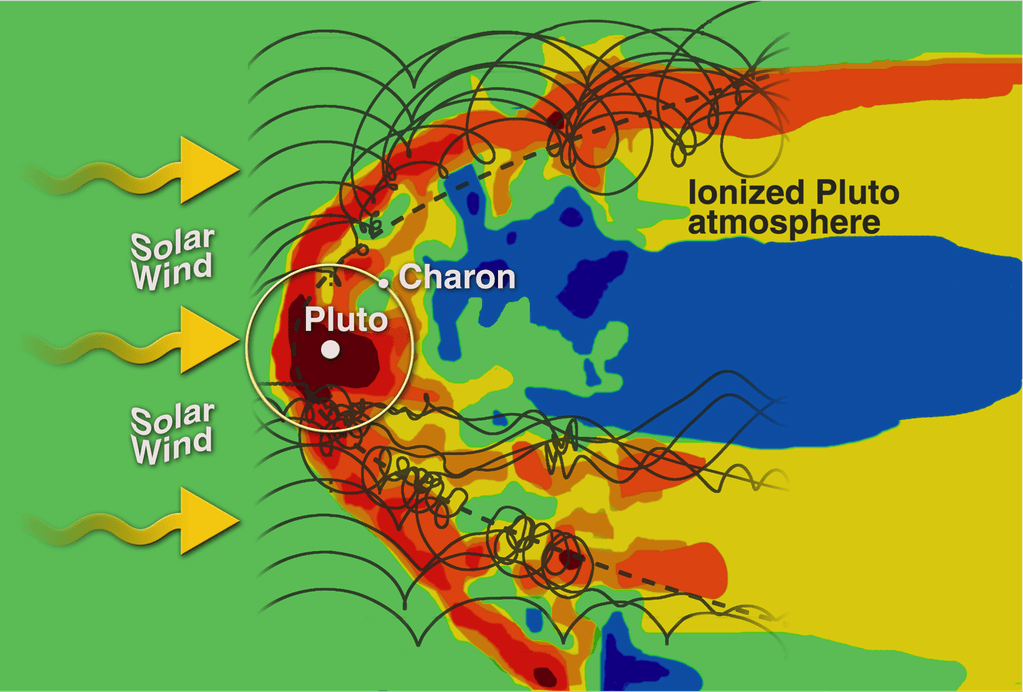
The New Frontiers spacecraft was built by a team led by Stern and included researchers from SwRI and the Johns Hopkins University Applied Physics Laboratory (APL) in Laurel, Maryland. APL also operates the New Horizons spacecraft and manages the mission.
Stay tuned here for Ken’s continuing Earth and planetary science and human spaceflight news.
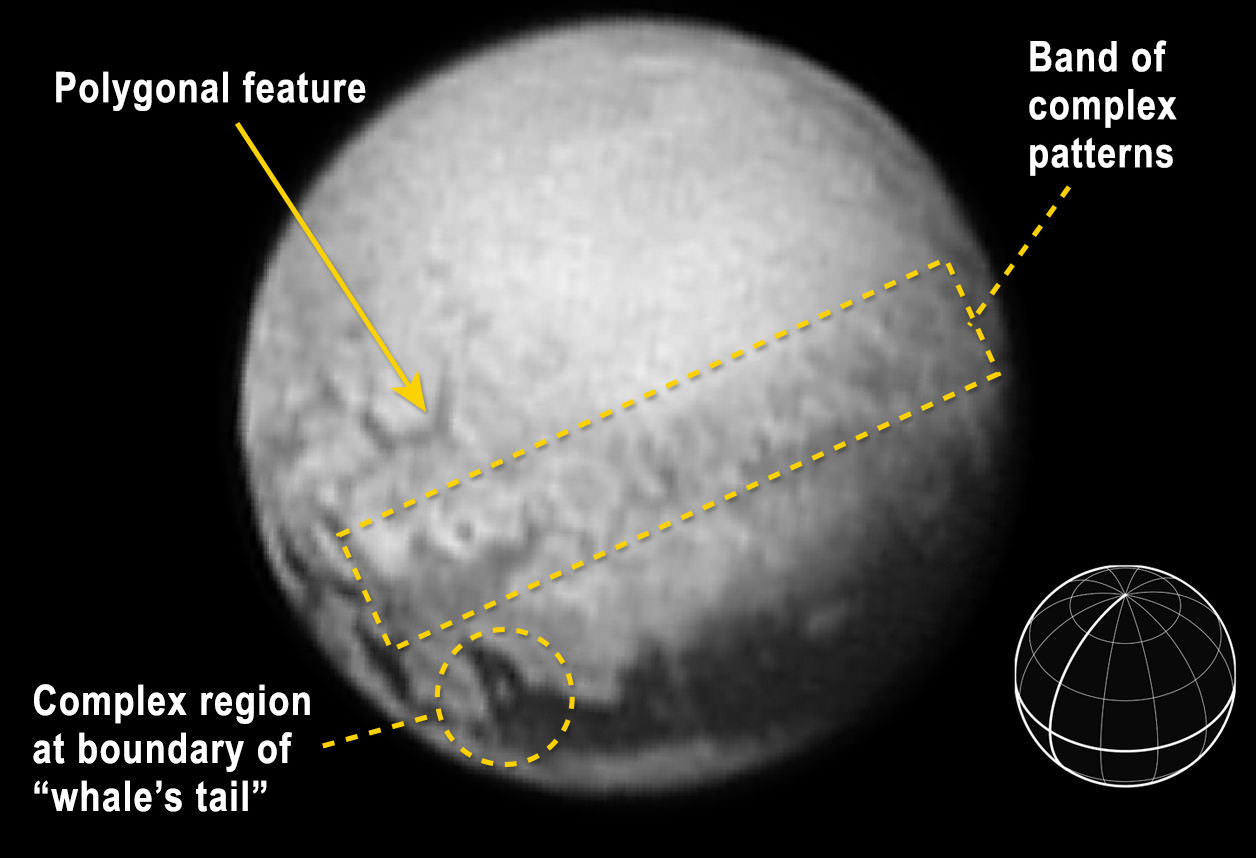
Pluto’s ‘Heart’ Revealed as New Horizons Probe Starts Flyby Campaign: 5 Days Out

The Huge Heart of Pluto
Pluto’s “Heart” is seen in this new image from New Horizons’ Long Range Reconnaissance Imager (LORRI) received on July 8, 2015 after normal science operations resumed following the scary July 4 safe mode anomaly that briefing shut down all science operations. It shows ‘the heart and the whale’ along Pluto’s equator. The LORRI image has been combined with lower-resolution color information from the Ralph instrument. Credits: NASA-JHUAPL-SWRI
Story updated[/caption]
Emotions are rising exponentially with the rousing revelation that Pluto has a huge ‘Heart’ as revealed in stunning new imagery received just today (July 8) from NASA’s New Horizons spacecraft – which has also officially started its intensive flyby campaign merely 5 days out from humanity’s history making first encounter with the last unexplored planet in our Solar System on Tuesday, July 14.
Notably, today’s image showing Pluto’s ‘heart-shaped’ surface feature proves that New Horizons is now fully back in business following the nail-biting July 4 weekend anomaly that unexpectedly sent the probe into a protective status known as ‘safe mode’ and simultaneously sent mission engineers and scientists scurrying to their computer screens to resolve the scary issues and recover the probe back to full operation – just in the nick of time.
The intriguing ‘heart’ is the brightest area on Pluto and “may be a region where relatively fresh deposits of frost—perhaps including frozen methane, nitrogen and/or carbon monoxide—form a bright coating,” say mission scientists.
While in ‘safe mode’ all science operations were temporarily halted for nearly three days as the spacecraft inexorably zooms towards mysterious Pluto and its quintet of moons for our first up close reconnaissance of the frigid world and the Kuiper Belt.
Read my earlier story from July 6 here detailing how the science team and NASA resolved the July 4 anomaly and restored New Horizons to normal operations with little time to spare for its one time only flyby of the other ‘Red Planet’.
The close encounter sequence last for 9 days and it will take 16 months to relay back the vast quantity of data to be collected.
The view of Pluto’s ‘Heart’ was taken by the Long Range Reconnaissance Imager (LORRI) when the spacecraft was just under 5 million miles (8 million kilometers) from Pluto, and is the first to be received back on Earth since the anxiety rush caused by the July 4 anomaly.
The heart covers nearly half of Pluto’s now well resolved disk.
Right beside the large heart-shaped bright area, which measures some 1,200 miles (2,000 kilometers) across, is another enigmatic and elongated equatorial surface on the left side informally dubbed ‘the whale.’
Mission scientists say ‘the whale’ is one of the darkest regions visible to New Horizons and it measures some 1,860 miles (3,000 kilometers) in diameter, making it about 50% wider that the ‘heart.’
Above ‘the whale and the heart’ lies Pluto’s polar region that images show is intermediate in brightness.
NASA also released another perspective view of ‘the whale and the heart’ as seen below.
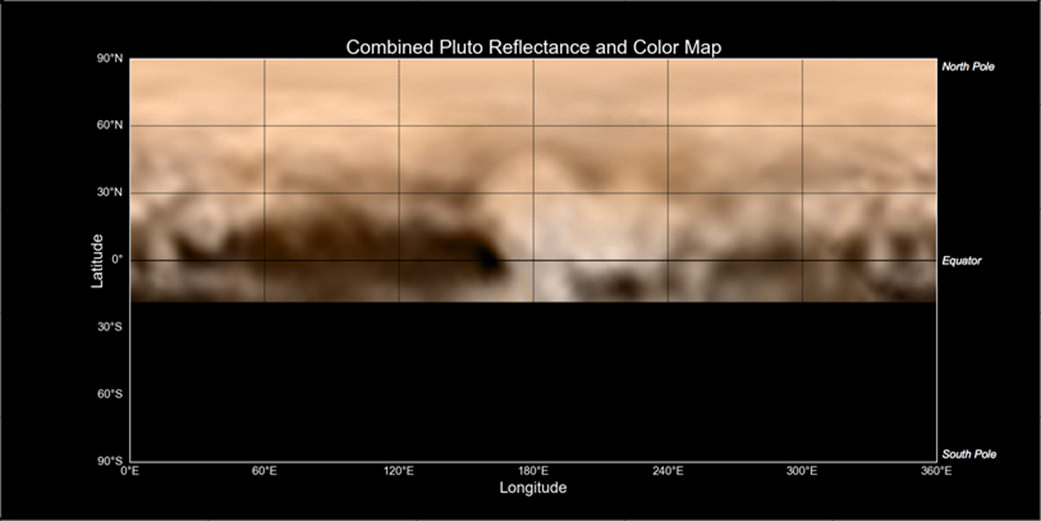
This map of Pluto, made from images taken by the LORRI instrument aboard New Horizons, shows a wide array of bright and dark markings of varying sizes and shapes. Perhaps most intriguing is the fact that all of the darkest material on the surface lies along Pluto’s equator. The color version was created from lower-resolution color data from the spacecraft’s Ralph instrument. Credits: NASA-JHUAPL-SWRI
Be sure to keep this entire area in mind – as if your appetites haven’t been whetted enough already – because “this view is centered roughly on the area that will be seen close-up during New Horizons’ July 14 closest approach,” says NASA.
“The next time we see this part of Pluto at closest approach, a portion of this region will be imaged at about 500 times better resolution than we see today,” said Jeff Moore, Geology, Geophysics and Imaging Team Leader of NASA’s Ames Research Center, in a statement. “It will be incredible!”
With barely 5 days to go until the once-in-a-lifetime opportunity for a fast flyby encounter of the ever intriguing binary planet traveling at the far flung reaches of the solar system, last minute glitches are the last thing anyone needs.
Why? Because there are no second chances as New Horizons barrels towards the Pluto system at approximately 30,000 miles per hour (over 48,000 kilometers per hour), which forms a binary planet with its largest known moon – Charon.
“The New Horizons spacecraft and science payload are now operating flawlessly,” Alan Stern, New Horizons principal investigator, Southwest Research Institute, Boulder, Colorado, announced at the July 6 post anomaly media briefing.
The nature of Pluto’s features that may appear to resemble craters or volcanoes is not yet known.
“We should be very cautious in interpreting these features,” Stern told Universe Today.

New Horizons will swoop to within about 12,500 kilometers (nearly 7,750 miles) of Pluto’s surface and about 17,900 miles (28,800 kilometers) from Charon during closest approach at approximately 7:49 a.m. EDT (11:49 UTC) on July 14.
TThe probe was launched back on Jan. 19, 2006 on a United Launch Alliance Atlas V rocket on a 9 year voyage of over 3.6 billion miles (5.7 billion km).
“We are on our way to Pluto!” exclaimed Jim Green, director of Planetary Science, NASA Headquarters, Washington, at the July 6 news media briefing. “It’s really a historic time, fraught with many decisions and challenges on the way to the July 14 Pluto system encounter.”
“With Pluto in our sights, we’re going for the gold.”

The New Frontiers spacecraft was built by a team led by Stern and included researchers from SwRI and the Johns Hopkins University Applied Physics Laboratory (APL) in Laurel, Maryland. APL also operates the New Horizons spacecraft and manages the mission.
Stay tuned here for Ken’s continuing Earth and planetary science and human spaceflight news.

A Brief History of Nukes in Space
In just a few short weeks, NASA’s New Horizons spacecraft will make its historic flyby of Pluto and its moons. Solar panels are unable to operate in the dim nether regions of the outer solar system, and instead, New Horizons employs something that every spacecraft that has thus far ventured beyond Jupiter has carried in its tool kit: a plutonium-powered Radioisotope Thermoelectric Generator, or RTG.
The use of nuclear power to explore space is one of the few happy chapters of the post atomic age, and nuclear power may one day give us access to the stars.
In the 1950s, atomic energy was seen as a panacea as well as a curse, a sort of Sword of Damocles that both hung over the human race, while also holding the promise of its salvation. This was before the disasters in Fukushima Daiichi, Chernobyl and Three Mile Island, which would serve to sour the public to all things nuclear.

But early space pioneers also recognized the potential for nuclear energy in space exploration. One of the more bizarre proposals of the early Space Age was a plan named Project A119 which called for the United States to detonate a nuclear weapon on the Moon in full view of the Soviet Union as a show of power. Another interesting proposal dubbed Project Orion called for the construction of an interstellar spacecraft that would be propelled by atomic bombs detonated to its aft. And the very first human artifact shot into space may well have been a one ton steel plate that was accidentally propelled at high speed skyward during the Pascal B nuclear test in the Operation Plumbbob series on August 27th, 1957. And the United States did indeed detonate nuclear weapons in space before the advent of the Limited Test Ban Treaty of 1967 that later forbade such tests. One amazing (and, as a child of the Cold War, very eerie to watch) such test known as Starfish Prime was carried out over the South Pacific in 1962:
One of the first spacecraft that sported an RTG was the Transit-4A satellite launched on June 29th, 1961. Another similar satellite in the series, Transit-5BN-3, was lost shortly after launch along with its plutonium-fueled RTG, which reentered over the Indian Ocean. The Soviet satellite Kosmos 954 also reentered over the Canadian high Arctic in early 1978 along with its onboard nuclear reactor.
And when Apollo 13 returned to Earth, the crew jettisoned the Aquarius lunar landing module over the Pacific, where it reentered along with its plutonium RTG meant for the ALSEP experiments that the Apollo astronauts placed on the Moon during every mission.

Every launch from Cape Canaveral of a nuclear RTG is sure to draw a scattering of protesters, though NASA estimated a catastrophic launch failure involving an RTG rupture during the New Horizons launch at 1-in-360. These fears reached a crescendo during the launch of Cassini in 1997, which also featured an Earth slingshot flyby on August 18th, 1999 en route to Saturn.
A nuclear RTG works by utilizing the waste heat generated by the radioactive decay of plutonium-238. This not only has a half-life of 87.7 years, but it also generates a very respectable 560 watt-seconds per kilogram per second. Unfortunately, the stuff we weaponize for nuclear bombs is a separate isotope known as Pu-239, and it can’t be repurposed for RTG use. The production of plutonium-239 for nuclear weapons during the Cold War did, however, also assure that the capability to also create Pu-238 for spaceflight was on hand until production was ended in the United States in 1989.

A roll call of RTG-equipped spacecraft reads like a ‘Who’s Who’ of outer solar system space exploration and includes: Pioneer 10 and 11, Galileo, Cassini, the Mars Science Laboratory, Voyagers 1 and 2, Vikings 1 and 2, and the aforementioned New Horizons spacecraft bound for Pluto.
Fun Fact: the plutonium powering Curiosity as it explores Mars was actually bought by NASA from the Russians.
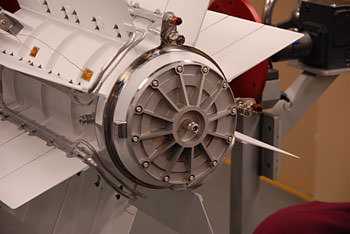
As of this writing, the Mars Rover 2020 mission is the next spacecraft to break the surly bonds that will sport, like Curiosity, a plutonium-powered MMRTG. A proposed Uranus Orbiter mission named HORUS (This stands for—deep breath— the Herschel Orbiter for Reconnaissance of the Uranus System, because ‘Uranus Probe’ just doesn’t sound right) would have also utilized and RTG. The Europa Clipper mission to Jupiter’s moon Europa set to launch around 2025 chose solar cells over a nuclear RTG, though it’ll have to thread through the perilous radiation environment surrounding Jupiter. In fact, the Juno spacecraft set to enter orbit around the planet Jupiter next year will be the first Jovian mission that won’t utilize nuclear power, though it requires three enormous solar panels to compensate.
Just how much plutonium NASA has on hand courtesy of the Department of Energy is classified for security reasons, but it’s thought to have enough for one large and one scout-class mission remaining. New Horizons incorporates 10.9 kilograms of plutonium, and it’s interesting to note that any alien civilization that finds a human spacecraft orbiting the plane of our Milky Way galaxy millions of years hence could date its manufacture from the radioactive decay of what very little Pu-238 versus decay isotopes remains in its RTG.

NASA has announced that the US Department of Energy will indeed resume the production of plutonium to the tune of about 1.5 to 2 kilograms a year starting in 2016. On the downside, NASA did, however, halt the development of its Advanced Stirling Radioisotope Generator (ASRG) in 2013. This is a somewhat contradictory decision, fueled more by politics than practicality given the current scarcity of plutonium. The ASRG design was to be four times more efficient than current MMRTGs (MM stands for Multi-Mission) and would have thus utilized less of the dwindling stockpile of existing Pu-238.
Sadly, the lingering shortage of plutonium may have a dire impact on the future of outer solar system space exploration. As Cassini, New Horizons and the Voyager spacecraft wrap up their respective missions, our ‘eyes on the outer solar system’ may go dark, as the current golden era of planetary exploration draws to a close for now, or at least, awaits a new generation of plutonium-powered spacecraft to take up the mantle.
The Hunt for KBOs for New Horizons’ Post-Pluto Encounter Continues
Are you ready for the summer of 2015? A showdown of epic proportions is in the making, as NASA’s New Horizons spacecraft is set to pass within 12,500 kilometres of Pluto — roughly a third of the distance of the ring of geosynchronous satellites orbiting the Earth — a little over a year from now on July 14th, 2015.
But another question is already being raised, one that’s assuming center stage even before we explore Pluto and its retinue of moons: will New Horizons have another target available to study for its post-Pluto encounter out in the Kuiper Belt? Researchers say time is of the essence to find it.
To be sure, it’s a big solar system out there, and it’s not that researchers haven’t been looking. New Horizons was launched from Cape Canaveral Air Force Station on January 19th, 2006 atop an Atlas V rocket flying in a 551 configuration in one of the fastest departures from Earth ever: it took New Horizons just nine hours to pass Earth’s moon after launch.
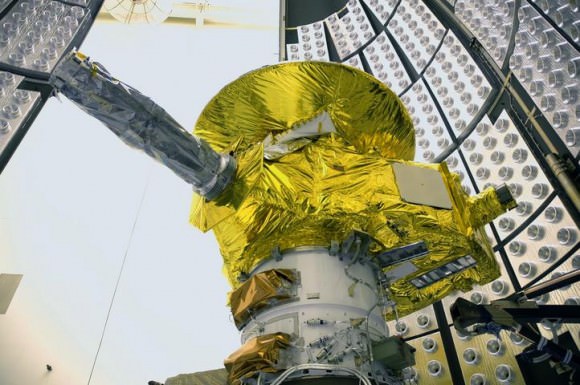
The idea has always been out there to send New Horizons onward to explore and object beyond Pluto in the Kuiper Belt, but thus far, searches for a potential target have turned up naught.
A recent joint statement from NASA’s Small Bodies and Outer Planets Assessment Groups (SBAG and OPAG) has emphasized the scientific priority needed for identifying a possible Kuiper Belt Object (KBO) for the New Horizons mission post-Pluto encounter. The assessment notes that such a chance to check out a KBO up close may only come once in our lifetimes: even though it’s currently moving at a heliocentric velocity of just under 15 kilometres a second, it will have taken New Horizons almost a decade to traverse the 32 A.U. distance to Pluto.
The report also highlights the fact that KBOs are expected to dynamically different from Pluto as well and worthy of study. The statement also notes that the window may be closing to find such a favorable target after 2014, as the upcoming observational apparition of Pluto as seen from Earth — and the direction New Horizons is headed afterwards — reaches opposition this summer on July 4th.
But time is of the essence, as it will allow researchers to plan for a burn and trajectory change for New Horizons shortly after its encounter with Pluto and Charon using what little fuel it has left. Then there’s the issue of debris in the Pluto system that may require fine-tuning its trajectory pre-encounter as well. New Horizons will begin long range operations later this year in November, switching on permanently for two years of operations pre-, during and post- encounter with Pluto.
And there currently isn’t a short-list of “next best thing” targets for New Horizons post-Pluto encounter. One object, dubbed VNH0004, may be available for distant observations in January of next year, but even this object will only pass 75 million kilometres — about 0.5 A.U. — from New Horizons at its closest.
Ground based assets such as the Keck, Subaru and Gemini observatories have been repeatedly employed in the search over the past three years. The best hopes lie with the Hubble Space Telescope, which can go deeper and spy fainter targets.
Nor could New Horizons carry out a search for new targets on its own. Its eight inch (20 cm in diameter) LORRI instrument has a limiting magnitude of about +18, which is not even close to what would be required for such a discovery.
New Horizons currently has 130 metres/sec of hydrazine fuel available to send it onwards to a possible KBO encounter, limiting its range and maneuverability into a narrow cone straight ahead of the spacecraft. This restricts the parameters for a potential encounter to 0.35 A.U. off of its nominal path for a target candidate be to still be viable objective. New Horizons will exit the Kuiper Belt at around 55 A.U. from the Sun, and will probably end its days joining the Voyager missions probing the outer solar system environment. Like Pioneers 10 and 11, Voyagers 1 and 2 and the upper stage boosters that deployed them, New Horizons will escape our solar system and orbit the Milky Way galaxy for millions of years. We recently proposed a fun thought experiment concerning just how much extraterrestrial “space junk” might be out there, littering the galactic disk.
And while the crowd-sourced Ice Hunters project generated lots of public engagement, a suitable target wasn’t found. There is talk of a follow up Ice Investigators project, though it’s still in the pending stages.
Another issue compounding the problem is the fact that Pluto is currently crossing the star rich region of the Milky Way in the constellation Sagittarius. Telescopes looking in this direction must contend with the thousands of background stars nestled towards the galactic center, making the detection of a faint moving KBO difficult. Still, if any telescope is up to the task, it’s Hubble, which just entered its 25th year of operations last month.
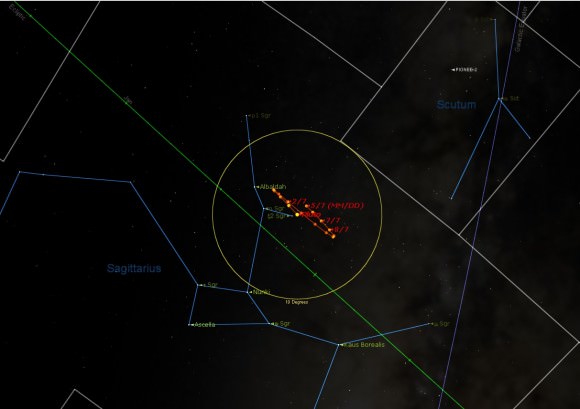
Shining at +14th magnitude, Pluto will be very near the 3.5th magnitude star Xi2 Sagittarii during the July 2015 encounter.
New Horizons is currently 1.5 degrees from Pluto — about 3 times the angular size of a Full Moon —as seen from our Earthly vantage point, and although neither can be seen with the naked eye, you can wave in their general direction this month on May 18th, using the nearby daytime Moon as a guide.
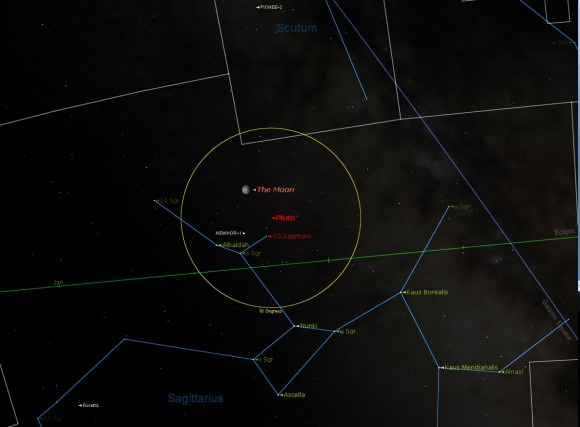
July 2015 will be an exciting and historic time in solar system exploration. Does Pluto have more undiscovered moons? A ring system of its own? Does it resemble Neptune’s moon Triton, or will it turn out looking entirely different ?
If nothing else, exploration of Pluto will finally give us science writers some new images to illustrate articles on the distant world, rather than recycling the half a dozen-odd photos and artist’s conceptions that are currently available. An abundance of surface features will then require naming as well. It would be great to see Pluto’s discoverer Clyde Tombaugh and Venetia Burney — the girl who named Pluto — get their due. We’ll even assume our space pundit’s hat and predict a resurgence of the “is it a planet?” debate once again in the coming year as the encounter nears…
Onward to Pluto and the brave new worlds beyond!

